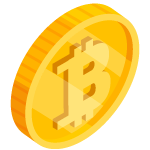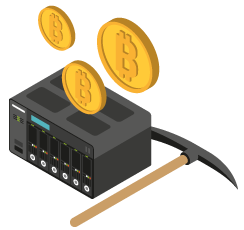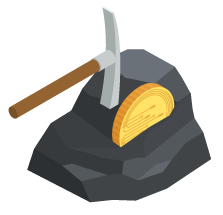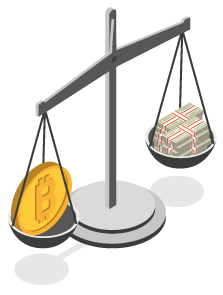
When you think of money, you likely don’t think of Bitcoin, but increasingly, that is changing. Quickly replacing fiat currency in many settings, cryptocurrency use is on the rise and the value has continually been predicted to increase over the next several years. Understanding exactly what Bitcoin is, though, its history, and how you can get started with it is key if you’re interested in the world of cryptocurrency.
So, Exactly What is Bitcoin?

If you’re wondering, “What is Bitcoin?,” you’re not alone. Bitcoin explained: it’s an online currency, also known as a cryptocurrency. It’s literally money that exists only on computers. If you have a Bitcoin balance, you have both a public and a private key that controls that balance. These keys are strings of numbers and letters that were generated by an algorithm. The public key is so others can send you Bitcoin. The private key authorizes that Bitcoin balance you have to go other places.
How Does It Work?

Any consideration of the question “What is Bitcoin” has to take a closer look of how it works. Bitcoin is really a collection of computers. Sometimes they’re called nodes. If you’re familiar with peer-to-peer technology, you already have an understanding of Bitcoin. Each node is a miner, literally a person with a computer that processes the transactions. The miners run the computer code behind Bitcoin and store the blockchain on their machines. If that term stumps you, think of blockchain as literally a collection of child’s blocks. Each one holds a group of Bitcoin transactions. Every computer in the node has exactly the same blocks with exactly the same transactions inside. As new blocks are made and filled with transactions, each computer can see them. That makes the entire system completely transparent. Currently, Bitcoin has 47,000 nodes, but the number of nodes involved is increasing. Any time you look for the reality behind Bitcoin explained, you’ll find those nodes at the heart of the system.
What’s Involved in Mining?

Bitcoins are released by miners. They do so when they solve a difficult puzzle that uncovers a new block. The new block is added to the blockchain, which then adds and verifies every transaction record in the network. Most use a variety of different hardware to mine. ASIC computer chips and GPUs tend to get more rewards faster, but the hardware used varies by the miner. The processors themselves, though, are typically called mining rigs.
Why Would Someone Be a Miner?

What motivates miners to run the system? They are paid in Bitcoin through the release of new currency as it is slowly released. The total supply of Bitcoin is just 21 million, and as the supply approaches that number, miners are paid at a slower and slower rate. In mid-2020, the number of Bitcoins not yet mined was just 3 million, so there will come a day when it’s impossible to get more Bitcoin. For each block added, a miner gets a few bitcoins, but that reward is cut in half for every 210,000 blocks that are added. In the earliest days of Bitcoin, a miner got 50 bitcoins per block. These days, they get about 6 bitcoins per added block.
Despite the fact that miners are paid for their work, many are motivated by something bigger – the credibility of a decentralized currency. That credibility relies on their authority, and because so many people are tired of the world of fiat currency and centralized banking systems, many miners work so hard to protect the blockchain because they know it offers something better.
The History of Bitcoin and Who Invented Bitcoin

Wondering how this cryptocurrency got started? While most people will pin 2009 as the most important year in the history of bitcoin, there are a number of events that happened well before Bitcoin was released that make it work. In 1997, Adam Back created Hashcash. The idea was to push computers (or users) to decode a tough algorithm to reduce profitability related to spam emails. Users had to engage their computers to complete a function that gave it access to the email service. Because Back believed spammers wouldn’t be willing to use the processing power to tackle the algorithm, he thought it would control the problems associated with spam. When the history of Bitcoin really took off in 2009, it was based on Back’s algorithm idea to build the mining function behind Bitcoin.
Who invented Bitcoin? The name associated with the history of Bitcoin is Satoshi Nakamoto, but that appears to be a pseudonym for a group of people who released the idea in the form of a white paper in 2008, then as a software in 2009. While there are some hints at who invented Bitcoin in reality, no one is entirely sure who Satoshi might really be. The creators likely remain anonymous for privacy reasons and safety concerns, as who invented bitcoin were likely those who were the earliest miners of Bitcoin and amassed quite a fortune doing so.
Getting Bitcoin

There are a number of ways to get Bitcoin. They can be accepted for products you sell or services you provide. Thanks to apps and QR codes, you can sell products in a physical store and accept Bitcoin for them. It’s even easier if you run an online business. There are even some jobs that pay you in Bitcoin, particularly those that are dedicated to the world of cryptocurrency. For example, there are job boards dedicated to cryptocurrency that connect independent contractors and those seeking to higher them based just on their desire to use cryptocurrency as a method of payment. You can also invest in it by purchasing Bitcoin with traditional currency.
Units of Bitcoin
Just like fiat currency, there are various units of Bitcoin. At the top of the chain is the Bitcoin itself. Next comes the Bitcent. It’s worth .01 of a Bitcoin. The Millibitcoin is next. It’s worth .001 of a Bitcoin. Then comes the Microbitcoin. It’s worth .000001 of a Bitcoin. The smallest unit is a Satoshi. It’s worth .00000001 of a Bitcoin. There are plenty of conversion sites available online so you can tell exactly what you’re going to get for your cash should you decide to exchange it for Bitcoin.
Storing Bitcoin

If you have Bitcoin, you store it in a wallet. This can be a physical device or a digital one. It helps you track your balance and send and receive Bitcoin. There are a few different kinds of wallets. They can be hardware-based or based on the web. It can sit on your phone, on your computer’s desktop, or as a print-out on your physical desk. Because there is a risk for fraud associated with Bitcoin, how you store yours is key to keeping it safe. Every wallet has one thing in common – private keys that allow you to access the currency. If you lose those keys or have them stolen, you can never access your Bitcoin again.
Is Bitcoin Better Than Fiat Currency?

There are some real benefits to using Bitcoin instead of fiat currency. It means you have more autonomy over your money. You can control how and where you spend it without dealing with a bank or even a government. It also means a level of privacy you just can’t get with traditional currency. Unless you make a list of your transactions, they’re likely never to be tracked back to you. Traditional banking fees also don’t exist with Bitcoin, and there aren’t really any transaction fees associated with international payments. It’s easier to make mobile payments, and Bitcoin tends to be more accessible to an entire population, which is a problem for the unbanked today.
The Many Myths Surrounding Bitcoin

Because Bitcoin remains largely misunderstood, there are many myths floating around about this cryptocurrency. One of the most pervasive is the ideas that they’re illegal. In most countries, that’s just not true. It is typically classified as a virtual currency, and throughout the world, most countries recognize that virtual currencies exist and that they are legal to use. Another pretty common myth is that Bitcoins are only used in illegal transactions. That’s not really true either. While some criminals certainly use Bitcoin, plenty use legal tender as well. Bitcoins are widely used for all kinds of legal transactions. Microsoft accepts Bitcoin as payment. In Germany, the fast-food restaurant Burger King accepts Bitcoin as payment for online orders. The U.S. based coffee giant Starbucks accepts it, as does the UK site OrderTakeaways. Just as any currency may be used in criminal enterprises, so too can Bitcoin, but it’s an incredibly legitimate choice, too.
Unfortunately, the myths surrounding Bitcoin don’t end there. Some believe Bitcoins are free to miners. Bitcoins are given away to miners as a reward for processing and verifying transactions in the blockchain, but mining bitcoins in this manner certainly isn’t free. Instead, it takes thousands of pounds worth of computer equipment and plenty of time to uncover new blocks and get rewarded with Bitcoins.
Maybe the most damaging myth about Bitcoin, and possibly the one holding you back from an investment, is that only the tech-savvy can understand and invest. After all, there’s a lot of jargon that goes into this cryptocurrency, and it can be overwhelming. The reality, though, is that anyone can become part of the Bitcoin world. Getting started is as simple as deciding on a wallet that meets your needs, then exchanging cash for Bitcoin. Bitcoin explained, or in short, is going to tell you that holding back from an investment like this one means missing an opportunity.
A Few Final Words

After the economic collapse at the end of the first decade of the 2000s, many looked for a currency reality that wouldn’t be tied to a government that could easily find itself in trouble. Bitcoin has become that currency for many who have chosen to get involved in the network, and while it may seem complicated from the outside looking in, the reality is that it’s an incredibly easy option to understand. It’s even easier to get involved with Bitcoin once you know and understand a few basics.
While you may hear lots of myths surrounding this popular cryptocurrency, it can be easy to get lost in the details and not invest. Instead, do you research. Understand the benefits and the drawbacks of Bitcoin and take a heard look at where it might have a place in your life. While it may not replace all of your currency needs, you are likely to find some pretty powerful ways to invest and use your investment in the world of Bitcoin. It’s not just a popular option. For many, it’s become a way of life that just can’t be replaced once more by fiat currency.